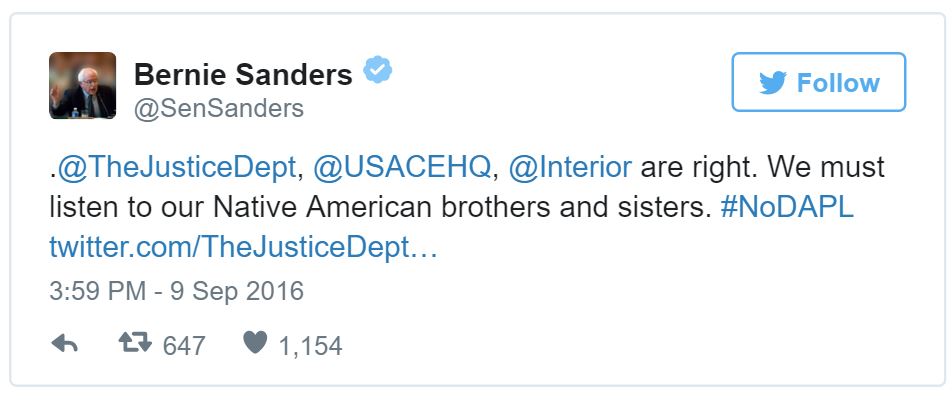- US Government Steps In After Judge Rules Against Standing Rock Sioux
- What You Need to Know About the Dakota Access Pipeline Protest
US Government Steps In After Judge Rules Against Standing Rock Sioux
Dierdre Fulton
Common Dreams
A series of "game-changing" developments impacting the Dakota Access Pipeline (DAPL) battle on Friday afternoon were testament to the power of organizing.
Striking a blow to the vibrant, Indigenous-led resistance movement that has sprung up against the four-state oil pipeline, a federal judge on Friday denied the Standing Rock Sioux Tribe's attempt to halt its construction.
Shortly afterward, however, the Department of Justice, the Department of the Army, and the Department of the Interior issued a joint statement indicating that "important issues raised by the Standing Rock Sioux Tribe and other tribal nations and their members regarding specifically, and pipeline-related decision-making generally, remain."
As a result, the statement read, construction on Army Corps land bordering or under Lake Oahe—which straddles North and South Dakota—will be halted until the Corps "can determine whether it will need to reconsider any of its previous decisions regarding the Lake Oahe site under the National Environmental Policy Act (NEPA) or other federal laws."
"In the interim," the agencies continued, "we request that the pipeline company voluntarily pause all construction activity within 20 miles east or west of Lake Oahe."
The statement continued:
Furthermore, this case has highlighted the need for a serious discussion on whether there should be nationwide reform with respect to considering tribes’ views on these types of infrastructure projects. Therefore, this fall, we will invite tribes to formal, government-to-government consultations on two questions: (1) within the existing statutory framework, what should the federal government do to better ensure meaningful tribal input into infrastructure-related reviews and decisions and the protection of tribal lands, resources, and treaty rights; and (2) should new legislation be proposed to Congress to alter that statutory framework and promote those goals.
Sen. Bernie Sanders, who on Thursday proposed legislation that would prevent the Army Corps from approving the pipeline until the agency has completed an environmental impact statement, praised the agencies' decision:
As Common Dreams has reported extensively, the Standing Rock Sioux had challenged the Army Corps of Engineers' decision to grant permits for Dallas-based Energy Transfer Partners' $3.8 billion pipeline, saying that the project violates federal laws—including the Clean Water Act and National Historic Preservation Act—and would endanger both water supplies and ancient sacred sites.
But in his decision (pdf), U.S. District Judge James Boasberg in Washington, D.C., said "the Tribe has not carried its burden to demonstrate that the Court could prevent damage to important cultural resources by enjoining the Corps' DAPL-related permitting."
He ordered the parties to appear for a status conference on Sept. 16.
Still, those who have voiced their opposition to the controversial project said they'd fight on.
In the lead-up to the ruling, tribal chairman David Archambault II declared: "Regardless of the court's decision today, we will continue to be united and peaceful in our opposition to the pipeline. Our ultimate goal is permanent protection of our sacred sites and our water. We must continue to have faith and believe in the strength of our prayers and not do anything in violence. We must believe in the creator and good things will come."
Earthjustice, who filed the lawsuit in July on behalf of the tribe, said in the days before the ruling that it would be challenged.
A press conference and protest will take place at the North Dakota Capitol starting at 3pm local time on Friday. Solidarity events are planned nationwide next week.
Updates are being shared under the hashtags #NoDAPL, #RezpectOurWater, and #StandWithStandingRock.
What You Need to Know About the Dakota Access Pipeline Protest
Gail Ablow
BillMoyers.com
Over the past month, thousands of protesters, including Native Americans from more than 100 tribes across the country, have traveled to North Dakota to help the Standing Rock Sioux Tribe block the Dakota Access Pipeline from being built.
Last week, the Standing Rock Nation filed an emergency petition to overturn the Army Corps of Engineers’ permit for the pipeline, which will be located a half-mile from the reservation through land taken from the tribe in 1958. The tribe says they were not consulted and a survey of the area found several sites of “significant cultural and historic value” in the pipeline path, including burial grounds.
But on Saturday, Dakota Access crews began bulldozing anyway, leading to a violent confrontation between protesters and security guards. Democracy Now!’s Amy Goodman was at the construction site as security guards attacked protesters with pepper spray and dogs.
On Tuesday this week, the Standing Rock Sioux were in federal court to prevent the Dakota Access Pipeline bulldozers from further destroying sacred sites. A US district judge temporarily stopped work on the pipeline, but then today issued a ruling clearing the way for work to continue. A lawyer for the tribe stated that they would appeal the decision.
Shortly after that ruling Friday afternoon, Indian Country Today reports that the “US Department of the Interior, Department of Justice and Army Corps of Engineers issued a joint statement that, in effect, temporarily halts all construction bordering Lake Oahe on the Missouri.”
What is it?
The Dakota Access Pipeline Project (DAPL) is a $3.78 billion conduit being built from the oil-rich Bakken fields in North Dakota, near the Canadian border, through South Dakota and Iowa, to Patoka, Illinois, where it will join up with existing pipelines to transport up to 570,000 barrels a day of crude to refineries and markets in the Gulf and on the East Coast. The Army Corps of Engineers approved the project in July with a “fast-track” option, allowing it to run under the Missouri river. The “mega-pipeline” is 1,172 miles long, making it just 7 miles shorter than the proposed Keystone XL Pipeline that the Obama administration rejected last November after a seven-year battle. The parent company of Dakota Access LLC is Texas-based Energy Transfer Partners, whose board of directors includes Rick Perry, the former governor of Texas.
The Threat
The pipeline is being built near the Standing Rock Sioux Reservation near Cannon Ball, North Dakota. The tribe says the pipeline disturbs sacred sites, infringes on past treaty promises and tribal sovereignty, and is a significant danger to their water supply since it passes underneath the Missouri River — the main source of water for the reservation. An earlier proposal had the pipeline crossing the Missouri north of Bismarck, but authorities were concerned about the risk to the capital’s water supply in the advent of a pipeline spill.
The Protests
The protests began last January after North Dakota approved the pipeline project. Residents of the Standing Rock Sioux Reservation immediately petitioned the US Army Corps of Engineers to deny the final permit. In April, residents of the reservation and supporters from other tribes set up camp near the construction site to keep an eye on the pipeline workers who were waiting for approval and preparing to break ground.
Standing Rock youth launched a petition called Rezpect our Water, and in mid-July set out on a 500-mile relay run to Washington, DC to deliver a petition of 160,000 signatures. Officials at the Department of the Interior, the EPA and the Advisory Council on Historic Preservation voiced concerns. Dozens of environmental groups joined together to oppose it and celebrities spoke out, including Leonardo DiCaprio, Shailene Woodley and Jason Momoa and his Justice League co-stars, including Ben Affleck. The Army Corps of Engineers approved the permit in July.
On Aug. 10, construction began and a dozen demonstrators were arrested as they tried to stop it. The call for help went out, using social media and the #NoDAPL hashtag to spread information, and within a week hundreds of protesters arrived, swelling the ranks to more than 2,500. State officials shut down the highways leading to the site and removed state-owned water tanks that had been brought in by North Dakota’s Health Department earlier in the summer to serve the encampment. With thousands of protesters still gathered, Gov. Jack Dalrymple declared a state of emergency on Aug. 19.
On August 24, hundreds of protesters gathered in Washington, DC, in front of the federal courthouse waiting for a decision in the case, but the decision was delayed for further review. Today, federal Judge James E. Boasberg issued a ruling that “rejected efforts by the Standing Sioux Tribe to halt construction.” Shortly afterwards, the federal government issued a statement urging the company to pause construction.
The Process
The Dakota Access pipeline was fast-tracked from the beginning, using the Nationwide Permit 12 process that treats the pipeline as a series of small construction sites and grants exemption from the environmental review required by the Clean Water Act and the National Environmental Policy Act. And since it does not cross an international border, as the Keystone XL project did, it escaped a more probing federal analysis of its economic justification and environmental impact, according to the chairman of the Standing Rock Sioux tribe, David Archambault II, who wrote in a New York Times op-ed that they have been opposing the pipeline since they first learned of it in 2014.
Food and Water Watch mapped out the institutions that are bankrolling Dakota Access, LLC and its parent company, Energy Transfer Partners, and learned that the Standing Rock Sioux are pitting themselves against the financial interests of at least 17 firms that have loaned the company $2.5 billion to construct the pipeline.
The Media Silence
The images of guard dogs attacking protesters woke the mainstream media this past weekend, which has sparsely covered the growing opposition to the pipeline. Throughout the standoff, Mother Jones, Indian Country, AP and local papers like The Bismarck Tribune have provided ongoing coverage and analysis.
Gail Ablow is a producer for Moyers & Company and a Carnegie Visiting Media Fellow, Democracy.



Spread the word